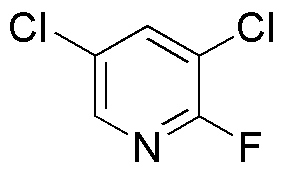3,5-Dichloro-2-fluoropyridine is widely utilized in research focused on:
- Pharmaceutical Development: This compound serves as an important intermediate in the synthesis of various pharmaceuticals, particularly in creating antiviral and antibacterial agents. Its unique structure allows for modifications that enhance drug efficacy.
- Agricultural Chemicals: It is used in the formulation of agrochemicals, including herbicides and fungicides. The chlorinated and fluorinated groups contribute to the compound's effectiveness in controlling pests while minimizing environmental impact.
- Material Science: The compound is explored in the development of new materials, particularly in the production of polymers and coatings that require enhanced chemical resistance and durability.
- Research Reagents: As a reagent in organic synthesis, it aids researchers in creating complex molecules, making it invaluable in academic and industrial laboratories for various chemical reactions.
- Environmental Studies: Its properties are studied in environmental chemistry to understand its behavior and degradation in ecosystems, helping to assess the risks associated with its use in agriculture and industry.
General Information
Properties
Safety and Regulations
Applications
3,5-Dichloro-2-fluoropyridine is widely utilized in research focused on:
- Pharmaceutical Development: This compound serves as an important intermediate in the synthesis of various pharmaceuticals, particularly in creating antiviral and antibacterial agents. Its unique structure allows for modifications that enhance drug efficacy.
- Agricultural Chemicals: It is used in the formulation of agrochemicals, including herbicides and fungicides. The chlorinated and fluorinated groups contribute to the compound's effectiveness in controlling pests while minimizing environmental impact.
- Material Science: The compound is explored in the development of new materials, particularly in the production of polymers and coatings that require enhanced chemical resistance and durability.
- Research Reagents: As a reagent in organic synthesis, it aids researchers in creating complex molecules, making it invaluable in academic and industrial laboratories for various chemical reactions.
- Environmental Studies: Its properties are studied in environmental chemistry to understand its behavior and degradation in ecosystems, helping to assess the risks associated with its use in agriculture and industry.
Documents
Safety Data Sheets (SDS)
The SDS provides comprehensive safety information on handling, storage, and disposal of the product.
Product Specification (PS)
The PS provides a comprehensive breakdown of the product’s properties, including chemical composition, physical state, purity, and storage requirements. It also details acceptable quality ranges and the product's intended applications.
Certificates of Analysis (COA)
Search for Certificates of Analysis (COA) by entering the products Lot Number. Lot and Batch Numbers can be found on a product’s label following the words ‘Lot’ or ‘Batch’.
*Catalog Number
*Lot Number
Certificates Of Origin (COO)
This COO confirms the country where the product was manufactured, and also details the materials and components used in it and whether it is derived from natural, synthetic, or other specific sources. This certificate may be required for customs, trade, and regulatory compliance.
*Catalog Number
*Lot Number
Safety Data Sheets (SDS)
The SDS provides comprehensive safety information on handling, storage, and disposal of the product.
DownloadProduct Specification (PS)
The PS provides a comprehensive breakdown of the product’s properties, including chemical composition, physical state, purity, and storage requirements. It also details acceptable quality ranges and the product's intended applications.
DownloadCertificates of Analysis (COA)
Search for Certificates of Analysis (COA) by entering the products Lot Number. Lot and Batch Numbers can be found on a product’s label following the words ‘Lot’ or ‘Batch’.
*Catalog Number
*Lot Number
Certificates Of Origin (COO)
This COO confirms the country where the product was manufactured, and also details the materials and components used in it and whether it is derived from natural, synthetic, or other specific sources. This certificate may be required for customs, trade, and regulatory compliance.
*Catalog Number
*Lot Number
Citations
Sign up and save
Entice customers to sign up for your mailing list with discounts or exclusive offers.


